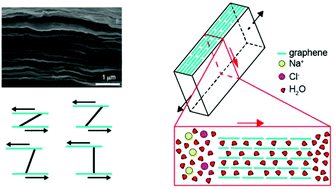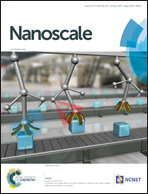Bio-inspired graphene-derived membranes with strain-controlled interlayer spacing†
Abstract
The precisely controlled size of nanoscale fluidic channels plays a critical role in resolving the permeation-selectivity trade-off in separation and filtration applications, where highly efficient gas separation and water desalination are targeted. Inspired by natural nacre where the spacing between mineral platelets changes upon applying tension as fractured mineral bridges climb over each other, bio-inspired graphene-derived membranes with sheets cross-linked by aligned covalent bonds are proposed in design, to ensure a controlled interlayer spacing ranging from 4 Å to 14 Å while preserving structural and mechanical stabilities by prohibiting swelling. The underlying mechanism is that the tension applied to the membrane is transferred between finite-sized graphene sheets through interlayer shear of the cross-links, which expands the interlayer gallery. First-principles calculations and continuum mechanics based model analysis are combined to explore the feasibility of this protocol, by considering the microstructures of graphene-derived membranes that have recently been demonstrated to offer exceptional performance in selective mass transport. The results show that the critical size range in molecular sieving is covered by this synergetic interface- and strain-engineering approach.



 Please wait while we load your content...
Please wait while we load your content...